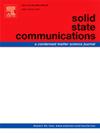Magnetic and transport properties of polar metal LiOsO3 based junction
IF 2.1
4区 物理与天体物理
Q3 PHYSICS, CONDENSED MATTER
引用次数: 0
Abstract
In this study, we investigate the electronic, magnetic, and transport properties of the polar metal LiOsO, focusing on the interplay between its crystalline structure, magnetic order, and spin–orbit coupling (SOC). Using a combination of density functional theory (DFT) and the non-equilibrium Green’s function (NEGF) method within the Landauer–Büttiker framework, we analyze the effects of LiOsO’s ferroelectric-like structural transition from a high-temperature centrosymmetric phase to a low-temperature non-centrosymmetric phase on its conductivity. Our calculations reveal that LiOsO is a weakly correlated material () and that the structural transition has negligible impact on its electronic and transport properties, with both phases exhibiting high conductance. This finding contrasts with the experimentally observed bad metallicity. However, introducing an antiferromagnetic configuration significantly reduces the conductance, bringing it closer to experimental values. We show that this magnetic order remains stable even in the presence of SOC. By increasing the spacer thickness in a Cu/LiOsO/Cu(111) junction, we observe a drop in conductance by an order of magnitude. Finally, Spin-spiral calculations indicate that the system favors a non-collinear magnetic ground state over a collinear configuration, providing an explanation for the absence of magnetic order in experimental observations. The combination of non-collinear magnetic ordering and the strong SOC of osmium suggests that LiOsO is a promising candidate for spintronic applications. These results provide new insights into the complex relationship between structural, electronic, and magnetic properties in polar metals.
极性金属LiOsO3基结的磁性和输运性质
在这项研究中,我们研究了极性金属LiOsO3的电子、磁性和输运性质,重点研究了其晶体结构、磁序和自旋轨道耦合(SOC)之间的相互作用。结合密度泛函理论(DFT)和landauer - b ttiker框架下的非平衡格林函数(NEGF)方法,我们分析了LiOsO3从高温中心对称相到低温非中心对称相的类铁电结构转变对其电导率的影响。我们的计算表明,LiOsO3是一种弱相关材料(U/W<1),结构转变对其电子和输运性质的影响可以忽略不计,两相都表现出高电导。这一发现与实验观察到的不良金属丰度形成对比。然而,引入反铁磁结构显著降低了电导,使其更接近实验值。我们表明,即使在SOC存在的情况下,这种磁顺序仍然保持稳定。通过增加Cu/LiOsO3/Cu(111)结中的间隔层厚度,我们观察到电导率下降了一个数量级。最后,自旋螺旋计算表明,该系统倾向于非共线磁基态而不是共线构型,这为实验观测中缺乏磁有序提供了解释。非共线磁有序和锇的强荷电性的结合表明,LiOsO3是一个有希望的自旋电子应用的候选者。这些结果为极性金属的结构、电子和磁性之间的复杂关系提供了新的见解。
本文章由计算机程序翻译,如有差异,请以英文原文为准。
求助全文
约1分钟内获得全文
求助全文
来源期刊

Solid State Communications
物理-物理:凝聚态物理
CiteScore
3.40
自引率
4.80%
发文量
287
审稿时长
51 days
期刊介绍:
Solid State Communications is an international medium for the publication of short communications and original research articles on significant developments in condensed matter science, giving scientists immediate access to important, recently completed work. The journal publishes original experimental and theoretical research on the physical and chemical properties of solids and other condensed systems and also on their preparation. The submission of manuscripts reporting research on the basic physics of materials science and devices, as well as of state-of-the-art microstructures and nanostructures, is encouraged.
A coherent quantitative treatment emphasizing new physics is expected rather than a simple accumulation of experimental data. Consistent with these aims, the short communications should be kept concise and short, usually not longer than six printed pages. The number of figures and tables should also be kept to a minimum. Solid State Communications now also welcomes original research articles without length restrictions.
The Fast-Track section of Solid State Communications is the venue for very rapid publication of short communications on significant developments in condensed matter science. The goal is to offer the broad condensed matter community quick and immediate access to publish recently completed papers in research areas that are rapidly evolving and in which there are developments with great potential impact.
 求助内容:
求助内容: 应助结果提醒方式:
应助结果提醒方式:


